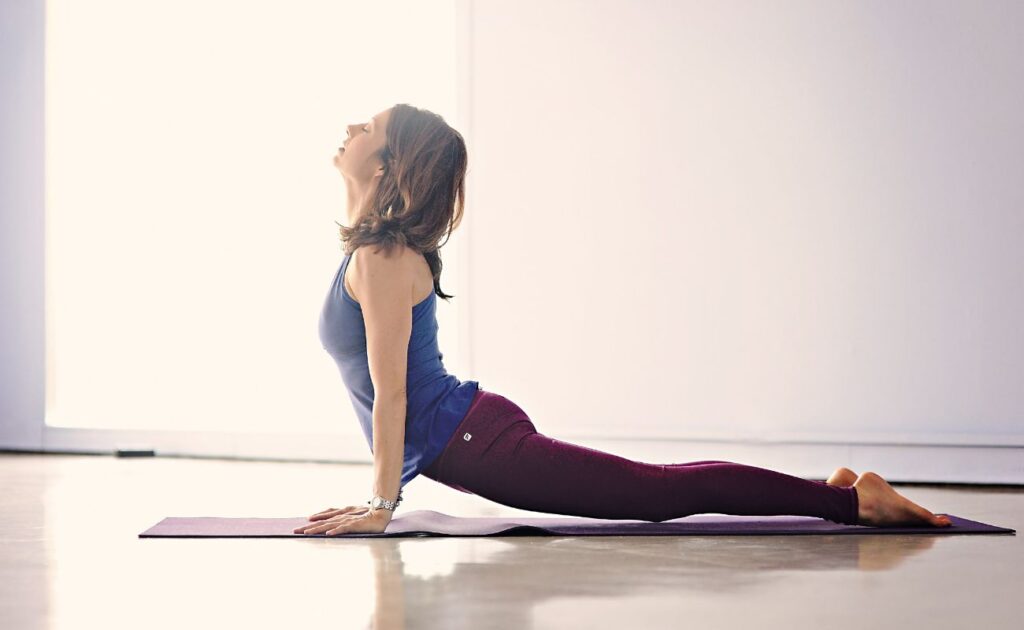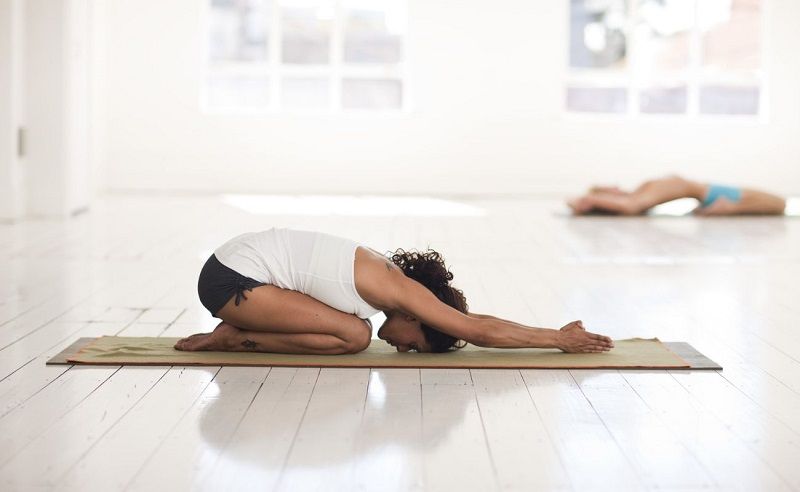
Yoga is an age-old discipline that combines body and mind. It brings many benefits to physical and mental health, whether to reduce stress, improve breathing, strengthen muscles, have a slim waist (figure) or even increase self-confidence.
👉 But how to choose the type of yoga that suits you best? What are the criteria to take into account to find the style of yoga that suits your needs and goals?
In this article, we will introduce you to the different types of yoga and their benefits, and give you some tips for practicing yoga at home or in class.

Different types of yoga: the 6 main ones
Yoga is a very varied discipline, which brings together many styles and movements. Each type of yoga has its own characteristics, its own objectives and its own benefits. It is therefore important to choose the type of yoga that suits you best, depending on your needs, your desires and your level.
👉 Here is a presentation of the main types of yoga and their benefits:
- Hatha yoga: this is the most traditional and popular type of yoga. It is based on the practice of postures (asanas) and breathing (pranayama). It aims to harmonize the body and mind, strengthen the muscles, soften the joints and soothe the mind. It is suitable for beginners, as it allows you to learn the basics of yoga at a moderate pace.
- Vinyasa yoga: it is a dynamic and fluid type of yoga, which connects postures by synchronizing breathing and movement. It aims to create a connection between body, breath and mind, to stimulate the cardiovascular system, to burn calories and to relieve stress. It is suitable for people looking for a sportier and more creative yoga.
- Ashtanga yoga: it is a very intense and demanding type of yoga, which follows a precise sequence of postures, always in the same order. It aims to develop strength, endurance, concentration and discipline. It is suitable for people who are looking for a physical and mental challenge, and who already have a good yoga practice.
- Bikram yoga: it is a type of yoga that is practiced in a room heated to 40°C and 40% humidity. It includes 26 postures and 2 breathing exercises, always in the same order. It aims to detoxify the body, improve blood circulation, increase flexibility and strengthen the immune system. It is suitable for people looking for an intense and purifying practice.
- Kundalini yoga: it is a type of spiritual and energetic yoga, which combines postures, breathing exercises, chants (mantras), gestures (mudras) and meditation. It aims to awaken kundalini, the vital energy which lies dormant at the base of the spine, to open the chakras, the energy centers of the body, and to access a higher state of consciousness. It is suitable for people seeking a deep and transformative experience.
- Prenatal yoga: this is a type of yoga specially designed for pregnant women. It is based on gentle postures adapted to each trimester of pregnancy, which aim to relieve pregnancy-related ailments, prepare the body and mind for childbirth, and create a bond with the baby. It is suitable for pregnant women looking for a moment of relaxation and well-being.
There are of course other types of yoga, such as Iyengar yoga, Anusara yoga, Nidra yoga and Hot yoga. Each has its particularities and advantages.
Top 10 Benefits of Yoga for Health and Well-Being

Whether you are looking to relax, tone up, limber up or connect with your inner self, yoga can provide many health benefits. Top 10:
- Improves strength and flexibility. By practicing the postures regularly, you will gain endurance and flexibility naturally over time. You will strengthen your muscles, bones and joints, and prevent pain and injuries.
- Reduces stress and anxiety. Yoga is known for its ability to reduce stress and promote relaxation. Indeed, multiple studies have shown that practicing yoga lowers levels of cortisol, the hormone linked to stress. In addition, yoga helps you become aware of your thoughts and emotions, and manage them more calmly.
- Improves sleep quality. Yoga promotes deeper, more restful sleep, by regulating the circadian rhythm and calming the nervous system. Good sleep is essential for your physical and mental health, as it allows your body and brain to regenerate.
- Stimulates the immune system. Yoga strengthens your natural defenses by increasing the production of white blood cells, which fight infections. It also improves blood and lymphatic circulation, which promotes the elimination of toxins and waste.
- Regulates body weight. Yoga can help you maintain or achieve a healthy weight by addressing several factors. On the one hand, it burns calories and increases basal metabolism. On the other hand, it reduces appetite and the urge to snack, by regulating the hormones of hunger and satiety (6). Finally, it improves self-esteem and body acceptance, which promotes a healthy relationship with food.
- Improves digestion. Yoga stimulates the functioning of the digestive system by massaging the internal organs and facilitating intestinal transit. It thus prevents digestive disorders such as constipation, bloating or heartburn.
- Improves breathing. Yoga places great emphasis on breathing, which is a key element of health. By practicing deep, conscious breathing exercises (pranayama), you will increase your lung capacity, your oxygenation and your vital energy. You will also improve your concentration, calm and mental clarity.
- Improves cardiovascular health. Yoga helps prevent cardiovascular disease by reducing blood pressure, cholesterol and blood glucose. It also improves heart function and endurance.
- Improves mental health. Yoga has positive effects on psychological well-being, reducing symptoms of depression, anxiety, obsessive-compulsive disorder or post-traumatic stress disorder. It also promotes mood, self-confidence, creativity and
- Improves self-awareness. Yoga is a practice that invites you to connect with your inner self, your sensations, your emotions and your needs. It helps you develop your intuition, wisdom and compassion. It also allows you to align with your values, your goals and your life mission.
Testimonials: Body yoga before and after
After a year of regular practice, yoga can transform your body and mind. To inspire you, here are some testimonials from people who have transformed their bodies thanks to yoga:
- Julie, 35 years old: “Before doing yoga, I was stressed, tired and self-conscious about my weight. Yoga allowed me to reconnect with myself, to feel calmer and more confident. I lost 10 kilos in one year and I feel more toned and more flexible.”
- Marc, 42 years old: “I suffered from chronic back and neck pain due to my work at the computer. Yoga helped me relieve my muscle tension, correct my posture and improve my blood circulation. I I no longer have back pain and I sleep better.”
- Léa, 28 years old: “I did yoga occasionally, but I wasn’t very diligent. I decided to take it seriously a year ago and I don’t regret it. Yoga has given me more strength, flexibility and endurance. I feel more energetic and happier.”
6 tips for practicing yoga at home or in class

Whether you decide to practice yoga at home or in class, there are some tips to follow to fully enjoy your session and progress in your practice. Here are the main ones:
- Choose a time and place conducive to relaxation. Yoga is ideally practiced in the morning or evening, when you are calmer and more available. Find a place where you will not be disturbed by noise or external demands. Create a pleasant atmosphere, with subdued lighting, soft music or scented candles.
- Wear comfortable and appropriate clothing. It is important to feel comfortable in your clothes when practicing yoga. Opt for breathable and stretchy clothing that does not restrict your movements. Prefer neutral or calming colors, which promote relaxation.
- Use good yoga equipment. To practice yoga safely, it is advisable to use good yoga equipment. The most important thing is to have a mat that does not slip and is not too thick, to avoid injuries and imbalances. You can also use accessories such as a brick, a strap or a cushion, which will help you achieve certain postures more easily.
- Start with beginner-level lessons. Whether you take lessons with a teacher or follow online videos, it’s important to start with beginner-level lessons. This will allow you to learn the basics of yoga, fundamental postures, correct breathing and body alignment. Don’t skip steps and progress at your own pace.
- Listen to your body and your sensations. Yoga is a practice that requires listening and self-respect. Do not force your muscles or joints, do not exceed your limits and do not try to imitate others. Pay attention to your body and your sensations, and adapt your practice according to your state of the day.
- Do not judge your practice or your progress. Yoga is not a competition or a performance. There is no good or bad yogi, there are only people who practice yoga with their own history, their own level and their own goal. Do not judge your practice or your progress, but rather appreciate the benefits that yoga brings you on all levels.
👉 Yoga exercises to do at home
- Tadasana (Mountain pose):
- Place your feet hip-width apart and stand with an upright posture and arms at your sides.
- Press into all four corners of your feet, stretch your spine, and maintain deep, even breathing.
- Stay in this position for 5 to 10 breaths.
- Adho Mukha Svanasana (Downward facing dog pose):
- Get on all fours with your hands under your shoulders and your knees under your hips.
- Stretch arms and legs to form an inverted V, keeping feet hip-width apart.
- Keep your head and neck relaxed and maintain deep, even breathing.
- Stay in this position for 5 to 10 breaths.
- Balasana (Child’s pose):
- Get on your knees and sit on your heels, leaving your arms at your sides.
- Lower your upper body toward the floor, keeping your arms straight in front of you.
- Maintain deep, even breathing and relax your body as much as possible.
- Stay in this position for 5 to 10 breaths.
- Setu Bandha Sarvangasana (Bridge pose):
- Lie on your back, bend your knees and place your feet hip-width apart.
- Raise your pelvis by pressing your feet into the floor, keeping your arms straight on the floor.
- Keep your head and neck relaxed and maintain deep, even breathing.
- Stay in this position for 5 to 10 breaths.
- Savasana (Corpse Pose):
- Lie on your back with your arms and legs extended away from your body.
- Close your eyes and relax your body as much as possible.
- Focus on your breathing and let your thoughts dissipate.
- Stay in this position for 5 to 10 minutes.
Here is a list of commonly used yoga equipment:
- Yoga mat: A yoga mat is an essential accessory for practicing yoga comfortably and safely. It provides a non-slip surface to prevent slips and falls during exercises.
- Yoga Blocks: Yoga blocks are used to help beginners achieve difficult poses and to improve body alignment. They are often made of foam or cork and can be used to support the hands, feet or back.
- Yoga Straps: Yoga straps are often used to help practitioners achieve poses that require greater flexibility, such as straight leg poses.
- Meditation Cushions: Meditation cushions are used to support the back and knees during meditation exercises. They can help maintain an upright and comfortable posture.
- Yoga Towels: Yoga towels are used to absorb sweat and prevent slipping during exercises. They can be placed on the mat or on the body.
- Yoga outfits: Comfortable and breathable clothing is recommended for practicing yoga, such as yoga pants, shorts and sports tops.
- Yoga accessories for advanced practice: Some accessories such as yoga chairs, yoga wheels, pull ropes, head supports and yoga benches can be used for more advanced practices or for specific postures.
Yoga: everything you need to know about this practice that transforms your body and mind

👉 Effects of yoga on the silhouette
Yoga is a practice that can have beneficial effects on the figure, depending on several factors.
Yoga can help with weight loss, by burning calories and increasing basal metabolism. It can also reduce appetite and the urge to snack, by regulating the hormones of hunger and satiety. Additionally, it can help manage stress and emotions, which are often the cause of weight gain
Yoga can strengthen muscles, working all muscle groups in the body deeply, but always gently. It can also improve posture, aligning the body and correcting imbalances. Thus, yoga can tone the silhouette and make it more harmonious.
Yoga can slim the waist, by stimulating the functioning of the digestive system and facilitating intestinal transit. It can also massage the internal organs and promote the elimination of toxins and waste. So, yoga can reduce bloating and abdominal swelling.
Yoga can have a different effect depending on the type of yoga practiced, the frequency and intensity of the sessions, the person’s diet, lifestyle and metabolism. Some types of yoga are more dynamic and sporty, such as Vinyasa yoga or Bikram yoga, while others are gentler and more relaxing, such as Hatha yoga or Nidra yoga.
What is the age to start yoga?
👉 Yoga is a practice that can be done at any age, whether you are a child, young person or senior.
- There is no minimum age to start yoga. Children can practice yoga as soon as they are able to follow instructions and concentrate. Yoga can be beneficial for children because it allows them to develop their motor skills, their creativity, their self-confidence and their management of emotions.
- There is no maximum age to start yoga. Seniors can practice yoga as long as they have no medical contraindications. Yoga can be beneficial for seniors because it helps them maintain flexibility, balance, strength and vitality. There are types of yoga suitable for seniors, such as gentle yoga or chair yoga.
- To start yoga, it is advisable to choose a beginner level class, which will teach you the basics of yoga, fundamental postures, correct breathing and body alignment. It is also recommended to speak to the teacher before class, to let them know that this is your first class, and to let them know if you have any injuries, recent operations or special conditions.
- To progress in yoga, it is important to be regular and consistent in your practice. It is better to practice a little every day than a lot once a week. It is also important to listen to your body and its sensations, and not to compare yourself to others. Yoga is not a competition or a performance, but a path to self-realization.
Yoga FAQs
Some frequently asked questions about yoga and their answers:
Which yoga is best for beginners?
Each person has their own preferences and expectations. However, certain types of yoga are more accessible and more suitable for beginners, such as Hatha yoga, Vinyasa yoga or prenatal yoga. These types of yoga are based on the practice of postures (asanas) and breathing (pranayama), and allow you to learn the basics of yoga at a moderate pace.
Can you do yoga in bed?
Yes, it is possible to do yoga in bed, provided you choose gentle and appropriate postures. Yoga in bed can be a great way to start or end the day, relaxing and gently stretching. There are special yoga sequences in bed, which aim to wake up the body and mind, or to promote sleep.
Is 20 minutes of yoga a day enough?
Yes, 20 minutes of yoga a day can be enough to enjoy the benefits of yoga, provided you are regular and consistent in your practice. It is better to practice 20 minutes a day than 2 hours once a week. Yoga is a discipline that requires perseverance and patience, and which is built over time.
How much yoga is too much?
There is no general rule for determining the ideal amount of yoga. It depends on several factors, such as the type of yoga practiced, the level of the practitioner, the physical and mental state of the day, etc. The most important thing is to listen to your body and its sensations, and not to force or exceed your limits. If you feel pain, fatigue or stress after your yoga session, you may have overdone it.
Should you eat before or after yoga?
It is advisable not to eat just before or after yoga, as this can disrupt digestion and interfere with the practice. It is best to wait at least 2 hours after a meal to do yoga, and at least 30 minutes after a session to eat. It is also important to hydrate properly before, during and after yoga.
There you go, I hope this FAQ on yoga was useful to you. If you have any other questions about yoga, please ask me.
Conclusion :
You have understood, yoga is a complete practice which brings you numerous benefits on all levels. Whether you are a beginner or experienced, there is a type of yoga adapted to your needs and desires. Don’t hesitate to do at home, find out about yoga classes near you, or follow online sessions on specialized sites.
Yoga is a discipline accessible to everyone, which will help you live better every day.



